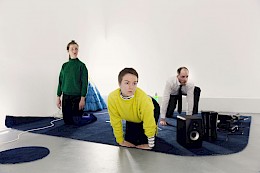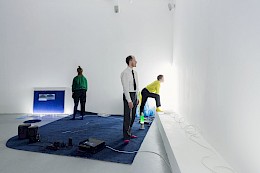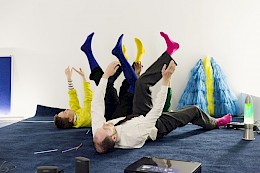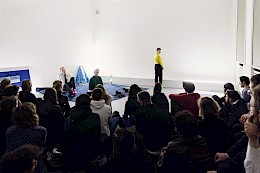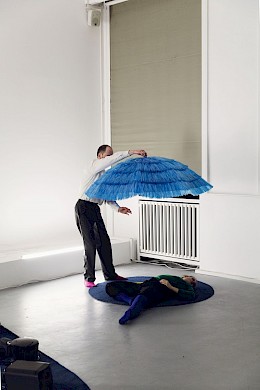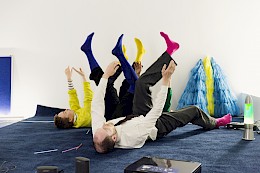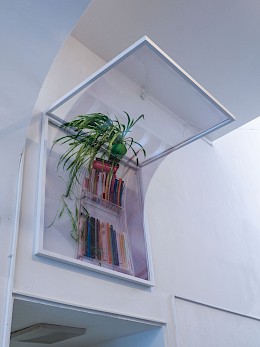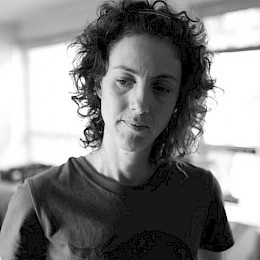Bernard Vienat (BV): How far does the idea of the exhibition, of a non-human world-scenario impact the creation your work?
Filippa Pettersson (FP): I developed this performance especially for the framework of the exhibition, so let’s say it was very present!
The performance is set in an office environment under water, where the audience can witness three creatures doing their routines. I wouldn’t call it a futuristic scenario, it’s rather an impression of these imagined beings that look and act a lot like humans. However, as the performance unfolds, it becomes clear that there is something off about them and that they are maybe not human at all. A lot of the performance circulates around thoughts about strangeness versus normality.
BV: Did you think about potential non-human worlds before or was it a new field for you?
FP: It was not really a new field. I took a university course called ‘deep ecology’ some years ago, which provided a good list of interesting writers on the topic of non-human worlds: Donna Haraway, Ursula K. Le Guin and Karen Barad, for example… I found these writers very inspiring. When I asked Tamara to join me to make this performance, she sent me some material of Timothy Morton that I also found interesting.
Tamara Antonijevic (TA): For me it was more by accident. I did some research about Jeffrey Jerome Cohen’s book Stone and I found this approach very inspiring to find a different perspective.
BV: Numerous books have been published on the post-human thematic, and artists are also developing projects about it. Is it for you mainly a creative challenge or do you also think of it as a real possibility in the near future of the earth?
TA: I don’t know if it’s a perspective for the future, I think it’s very possibly a trend where we imagine perspectives we can’t have, and also interesting that there is a desire to think from a different perspective or open up a different concepts and imaginaries, but somehow we are still limited by our situation. It’s more as an experiment: trying to think about it but also being aware of the fact that none of these approaches are ever fully able to step out of the human perspective.
BV: Do you think that art projects or artworks inspired by those speculative futures might have a direct impact on the viewer?
FP: I think it does, in the same way as any topic could. Such imaginative scenarios can open up new perspectives and inspirations, which is valuable. That’s what well-made artworks and exhibitions has the power to do.
BV: In your performance 7AM you deliberately let the performers indirectly address the viewer—what was the reason for this?
FP: The reason was to take this view of otherness and give it back to the humans themselves. The performers are disguised, they look like us and in some way act like us, but slowly the viewer realizes that they are not.
BV: How would you summarize the plot?
FP: The title 7AM is inspired by the routine of an office worker who usually would have to wake up around this time in order to be on time for work. The plot starts with the awakening of the creatures and follows their routines, using different gadgets and tools like a coffee machine or printer. They wake up and do their things, just like us, only they do it in a slightly different way.
BV : The text is as well really present in the performance; you named it “A Bony Structure”. How would you explained the relation of the title to the narrative, which appears in voice-over during the performance?
TA: The bony structure is for me it is inspired by this quote of Jeffrey Jerome Cohen where he says: “Humans walk upright over earth because the mineral long ago infiltrated animal life to become a partner in mobility”. So it’s not about discovering in the sense of progress, but it’s a way of revealing the things that are already there or see them from another angle.
BV: Would you say that the creatures you are staging might be, in this sense, part of new mythologies or rituals? Or do you see them as a potential evolution of the human being or other species?
TA: I dont think it’s an evolution. The idea was to start from something that was trying to become something else. It looks ordinary but something is weird about it. We were trying to find the particular logic in which these creatures are living. It looks a bit off, but it’s us, maybe with a small shift.
BV: Can you explain a little bit about why you started to focus on the question of normality and common acts, for instance, with this routine of waking up at 7 a.m.?
TA: We were trying to define what is everyday, what is normal and what are normal things to do. Normal is a stupid word to use, but there is a common idea of how you should live your life. I’m interested in this everydayness and seeing what is in it, because this is how we spend our time. To zoom in to those things and non-special gestures—small gestures that in this context become big events. That was the fantasy and the starting point of the text, that there is a meeting of audience and the performer, and then imagining how the relation works, and who has power over whom, and who is observing whom, and who has the right to stay or to leave.
BV: In the performance setting you have a sort of stage, and, in creating that distance, the viewer becomes situated more in a theatre, rather than an exhibition room. In this sense, his freedom to leave is limited. The text nevertheless makes clear that the viewer is free to leave but the performer on the stage is not. Is this again a process of reversing the role of the audience and performer?
TA: But that's not true in a way. That's the joke of it, telling you that you have power over me but I hold the power, like the gesture of turning off the light; that's also a manifestation of this.
BV: The performers are incarnated into alien creatures when the public become the center of their observation. Through this inversion of who is watching and who is the watcher, the viewer becomes a performer as well. Is it a way of bringing him in the role of the artist?
FP: For me it was more about the viewer becoming aware of the theme of otherness and human-ness, of looking at ‘the other’ and at the same time as being the one who is looked at. The inverted roles of performer and viewer is there as well but is maybe more connected to Tamara’s interest.
BV: Like other artists in the exhibition, you decided to express your ideas with many references to water. How come this relation between those non-human creatures and this fluid-aquatic world?
FP: Putting together an office world and underwater environment is an experimental thought. The combination of those two elements has something playful about it. On one side, the office can be seen as the most dry environment that you can imagine and, on the other side, the aquatic one as the most poetic one. Trying to project myself three hundred years from now into a non-human scenario, I imagined a lot of underwater scenarios, flooded landscapes, spaces covered with water. It might be part of a public subconscious.
